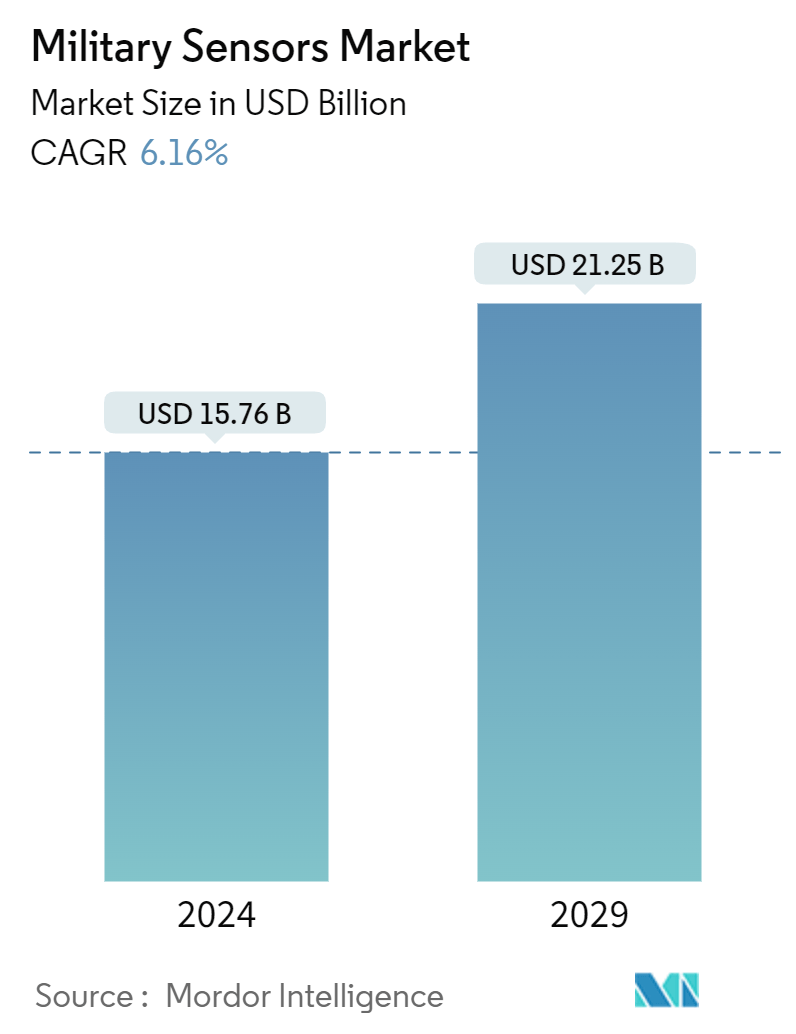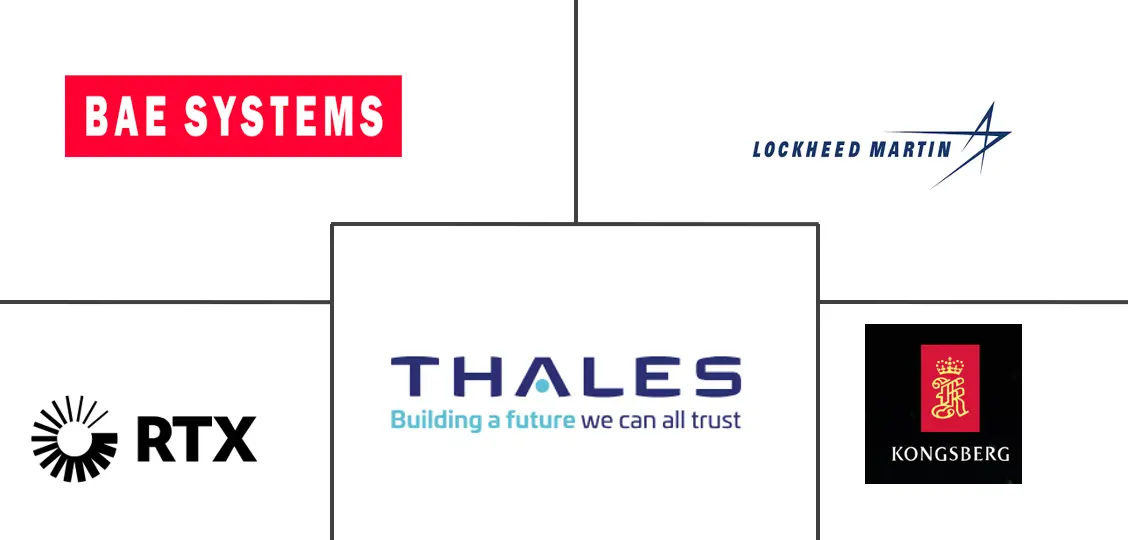Market Size of Military Sensors Industry

| Study Period | 2019 - 2029 |
| Market Size (2024) | USD 15.76 Billion |
| Market Size (2029) | USD 21.25 Billion |
| CAGR (2024 - 2029) | 6.16 % |
| Fastest Growing Market | Asia Pacific |
| Largest Market | North America |
Major Players
*Disclaimer: Major Players sorted in no particular order |
Military Sensors Market Analysis
The Military Sensors Market size is estimated at USD 15.76 billion in 2024, and is expected to reach USD 21.25 billion by 2029, growing at a CAGR of 6.16% during the forecast period (2024-2029).
The evolution and rapid adoption of microelectromechanical systems (MEMS)-based devices have led to the development of sophisticated micro gyros for navigation and positioning, microbolometers for infrared imaging, and micromirrors for steering laser beams. RF MEMS and nanotechnology could lead to breakthroughs in aerospace and defense applications, such as satellite communications at speeds over 100 GHz and electronically steerable RF phase shifters for true-time delay.
Modern military systems rely heavily on complex software and interconnectivity to perform their missions. Advanced features, such as electronic attacks, sensor fusion, and communications, of cyber-enabled military systems provide a tactical edge to the equipped armed forces against adversary forces or during critical operations in a hostile environment. Factors such as increasing demand for battlespace awareness amongst defense forces, ongoing advancements in MEMS technology, and integration of anti-jamming capabilities with navigation systems will drive the market growth. However, cybersecurity risks, complexity in the designs of military sensors, and lack of accuracy would constrain the market's growth.
Military Sensors Industry Segmentation
Several types of sensors are integrated into military systems to enhance their capabilities and ensure that the systems work according to their specifications. The study entails a comprehensive evaluation of the military sensors, including, but not limited to, electro-optical and infrared sensors, seismic sensors, acoustic sensors, magnetic sensors, pressure sensors, temperature sensors, torque sensors, speed sensors, level sensors, flow sensors, force sensors, angle of attack (AoA) sensors, and altimeters.
The military sensors market is segmented by application, platform, and geography. By application, it is divided into Intelligence, Surveillance, and Reconnaissance (ISR), communication and navigation, target recognition, electronic warfare, and command and control. By platform, it is divided into airborne, terrestrial, and naval. The report also covers the market sizes and forecasts for the military sensors market in major countries across different regions. For each segment, the market size is provided in terms of value (USD).
| Application | |
| Intelligence, Surveillance, and Reconnaissance (ISR) | |
| Communication and Navigation | |
| Target Recognition | |
| Electronic Warfare | |
| Command and Control |
| Platform | |
| Airborne | |
| Terrestrial | |
| Naval |
| Geography | ||||||||
| ||||||||
| ||||||||
| ||||||||
| ||||||||
|
Military Sensors Market Size Summary
The military sensors market is poised for significant growth, driven by advancements in microelectromechanical systems (MEMS) and nanotechnology, which are enhancing capabilities in navigation, infrared imaging, and laser beam steering. The integration of these technologies into modern military systems is crucial for maintaining a tactical advantage through features like electronic attacks, sensor fusion, and advanced communications. The increasing demand for enhanced battlespace awareness and the modernization of defense forces globally are key factors propelling market expansion. However, challenges such as cybersecurity risks, design complexities, and accuracy issues may hinder growth. The market is characterized by a semi-consolidated landscape with major players like RTX Corporation, Lockheed Martin, and BAE Systems competing to innovate and offer value-added sensor solutions.
The Asia-Pacific region is expected to lead in demand for military sensors, fueled by ongoing defense modernization programs and geopolitical tensions. Countries in this region are investing heavily in upgrading their military capabilities, with significant acquisitions such as Indonesia's deal for advanced drones. The rise of unmanned platforms, due to their cost-effectiveness and operational ease, is further driving market growth, particularly in airborne segments. Strategic collaborations among manufacturers to develop sophisticated sensors tailored to defense forces' specifications are also contributing to a positive market outlook. Notable contracts, such as those awarded to RTX Corporation and Leonardo DRS by the US Army, highlight the ongoing investment in advanced sensor technologies to enhance military operations.
Military Sensors Market Size - Table of Contents
-
1. MARKET DYNAMICS
-
1.1 Market Overview
-
1.2 Market Drivers
-
1.3 Market Restraints
-
1.4 Porter's Five Forces Analysis
-
1.4.1 Bargaining Power of Suppliers
-
1.4.2 Bargaining Power of Buyers/Consumers
-
1.4.3 Threat of New Entrants
-
1.4.4 Threat of Substitute Products
-
1.4.5 Intensity of Competitive Rivalry
-
-
-
2. MARKET SEGMENTATION
-
2.1 Application
-
2.1.1 Intelligence, Surveillance, and Reconnaissance (ISR)
-
2.1.2 Communication and Navigation
-
2.1.3 Target Recognition
-
2.1.4 Electronic Warfare
-
2.1.5 Command and Control
-
-
2.2 Platform
-
2.2.1 Airborne
-
2.2.2 Terrestrial
-
2.2.3 Naval
-
-
2.3 Geography
-
2.3.1 North America
-
2.3.1.1 United States
-
2.3.1.2 Canada
-
-
2.3.2 Europe
-
2.3.2.1 United Kingdom
-
2.3.2.2 France
-
2.3.2.3 Italy
-
2.3.2.4 Russia
-
2.3.2.5 Germany
-
2.3.2.6 Rest of Europe
-
-
2.3.3 Asia-Pacific
-
2.3.3.1 China
-
2.3.3.2 Japan
-
2.3.3.3 India
-
2.3.3.4 South Korea
-
2.3.3.5 Rest of Asia-Pacific
-
-
2.3.4 Latin America
-
2.3.4.1 Brazil
-
2.3.4.2 Mexico
-
2.3.4.3 Rest of Latin America
-
-
2.3.5 Middle East and Africa
-
2.3.5.1 Saudi Arabia
-
2.3.5.2 United Arab Emirates
-
2.3.5.3 South Africa
-
2.3.5.4 Rest of Middle East and Africa
-
-
-
Military Sensors Market Size FAQs
How big is the Military Sensors Market?
The Military Sensors Market size is expected to reach USD 15.76 billion in 2024 and grow at a CAGR of 6.16% to reach USD 21.25 billion by 2029.
What is the current Military Sensors Market size?
In 2024, the Military Sensors Market size is expected to reach USD 15.76 billion.

